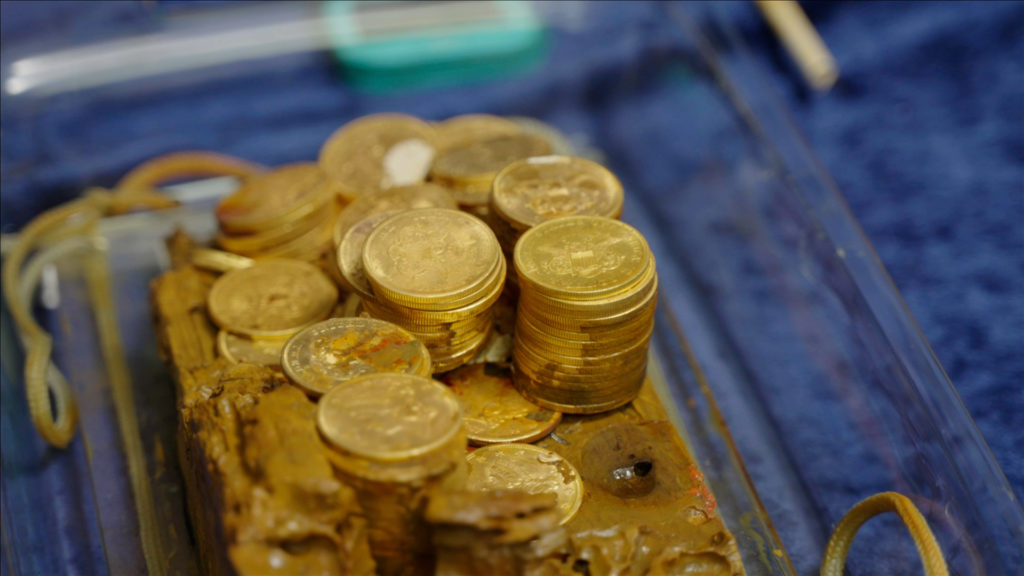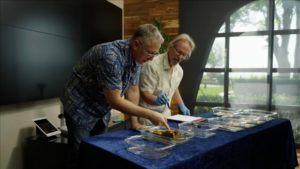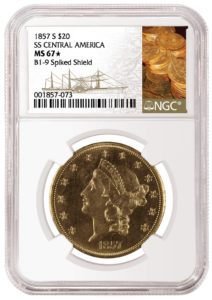On Sept. 3, 1857, the SS Central America began a voyage from Panama to New York carrying very important cargo—thousands of freshly minted gold coins from California desperately needed by New York banks facing an economic crisis.
Six days later, the ship found itself in the grips of a hurricane off the coast of the Carolinas. After three days of struggling with high winds and waves, the ship’s crew lost its battle with the storm, and the Central America sank, resulting in the loss of more than 400 lives and more than nine tons of gold. In the ensuing 130 years, treasure hunters dreamed of discovering the wreck, which quickly became known as the “Ship of Gold.” When it was finally discovered in the late 1980s, the process of retrieving its treasure began.
Numismatic Guaranty Company (NGC), a U.S.-based third-party grading service, has revealed what it called “the final mystery of the ship’s recovered cargo,” a box containing $20 gold coins from the height of the California gold rush, now certified, preserved and ready to be studied and appreciated by collectors around the world.
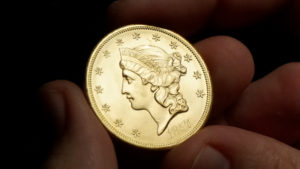
‘It’s the greatest treasure ever found in American history,’ according to Dwight Manley, the managing partner of the California Gold Marketing Group, which acquired the Central America’s lost coins.
‘SHIP OF GOLD’
California Gold Marketing Group acquired the Central America’s lost treasure from the salvagers who retrieved it from the wreck.
The group then entrusted NGC with the certification of the recovered coins, which Managing Partner Dwight Manley called “the greatest treasure ever found in American history” as well as “the greatest treasure ever lost in American history.”
“And it’s from a magical period in American history—the gold rush, the authentic United States gold rush, the biggest one in history.”
The coins NGC graded include 123 U.S. Liberty Head $20 gold coins, also known as “Double Eagles.”
The San Francisco Mint box containing the coins was transformed into a “concretion” by the conditions it endured during its time on the seafloor, according to NGC, who added the box’s contents were identified as coins, but their condition was unknown prior to its recent opening. After professional conservation, many of the coins were found to be of exceptional quality.
IMPRESSIVE PIECES
NGC Chair Mark Salzberg praised the coins’ condition, some of which he described as “fresh off the die.”
Among the most impressive pieces found in the box was one graded in high Mint-State (MS) condition, MS-67, with a “Proof-like” (PL) designation to make it the finest known PL example of an 1857-S $20 gold coin.
Another example with exceptional eye-appeal – graded MS-67 with a “Star” designation – is now the highest-graded 1857-S $20 gold coin to feature the NGC Star.
Four of the 1857-S $20 gold coins were graded MS-67-plus, indicating they approach the quality requirements of an MS-68, according to NGC.
To view a gallery of all 123 coins, which includes primarily 1857-S examples but also 1850, 1851, 1852, 1855-S and 1856-S coins, visit NGCcoin.com/SSCentralAmerica.
CALIFORNIA GOLD RUSH
The coins certified by NGC were minted with gold mined at the height of the California gold rush.
It was hoped their arrival in New York would bolster confidence in the U.S. financial industry, which was shaken by the announcement of the collapse of the Ohio Life Insurance & Trust Company in August 1857.
When the gold failed to arrive, it sparked what has come to be known as the Panic of 1857, the first global economic crisis.
The discovery of the shipwreck after more than a century of searching resulted in several expeditions to reclaim the lost cargo.
Bob Evans, the chief scientist of the Central America recovery efforts, was instrumental in locating artifacts, including the box of coins, from the legendary ship. Since the mineralization has been removed from the coins, they look “exactly the way they looked in 1857,” Evans said, with PL coins even stacked together in the box.
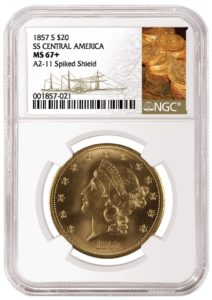
As the lost treasure was extracted from the box, each coin’s position in the box was catalogued by row, stack and the respective coin’s location in the stack.
As the coins were extracted from the “concretion,” each coin’s location in the box was catalogued according to row, stack and the respective coin’s place in the stack. These “coordinates” (appropriate for shipwreck coins) are indicated on the NGC certification label, on which “A” or “B” designates the row; the next number notes the stack; and the third number identifies the coin’s place in the stack. The NGC certification number for these coins also includes the year 1857.
“You’re talking about the end of a great, great story,” said Salzberg, who added the coins comprise “a world-renowned collection.”
The NGC-certified Central America coins are now available through select U.S. retailers.

